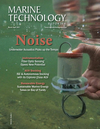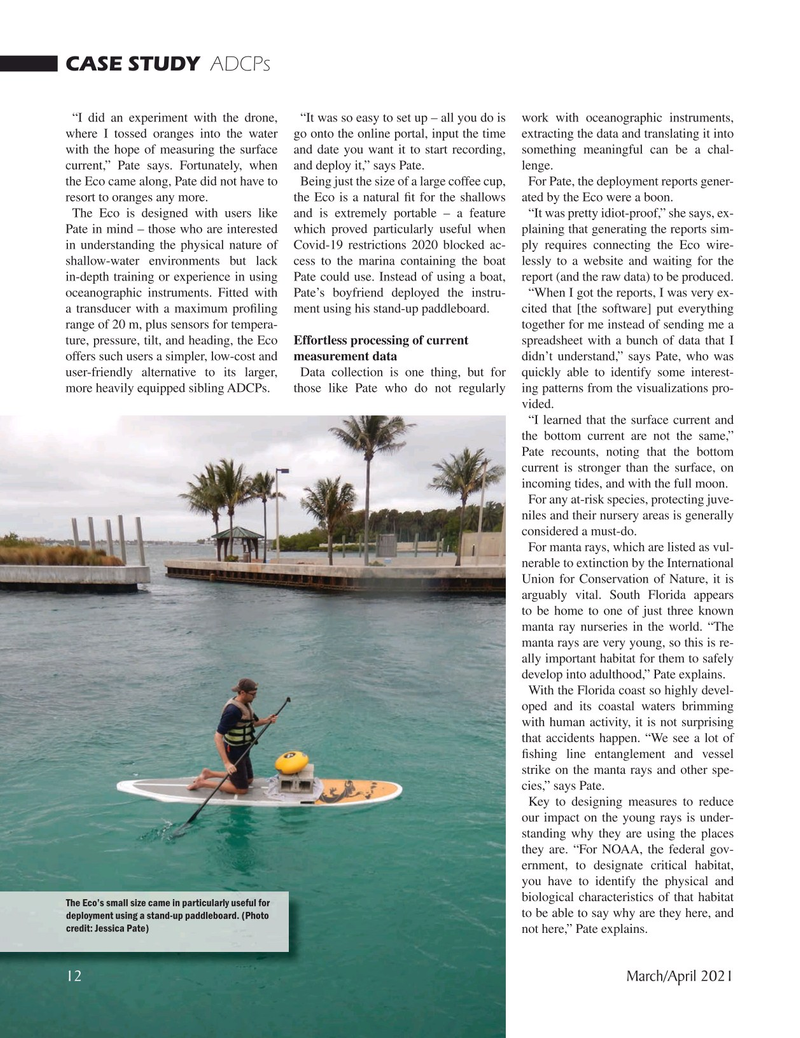
Page 12: of Marine Technology Magazine (March 2021)
Oceanographic Instrumentation & Sensors
Read this page in Pdf, Flash or Html5 edition of March 2021 Marine Technology Magazine
CASE STUDY ADCPs “I did an experiment with the drone, “It was so easy to set up – all you do is work with oceanographic instruments, where I tossed oranges into the water go onto the online portal, input the time extracting the data and translating it into with the hope of measuring the surface and date you want it to start recording, something meaningful can be a chal- current,” Pate says. Fortunately, when and deploy it,” says Pate. lenge. the Eco came along, Pate did not have to Being just the size of a large coffee cup, For Pate, the deployment reports gener- resort to oranges any more. the Eco is a natural ? t for the shallows ated by the Eco were a boon.
The Eco is designed with users like and is extremely portable – a feature “It was pretty idiot-proof,” she says, ex-
Pate in mind – those who are interested which proved particularly useful when plaining that generating the reports sim- in understanding the physical nature of Covid-19 restrictions 2020 blocked ac- ply requires connecting the Eco wire- shallow-water environments but lack cess to the marina containing the boat lessly to a website and waiting for the in-depth training or experience in using Pate could use. Instead of using a boat, report (and the raw data) to be produced.
oceanographic instruments. Fitted with Pate’s boyfriend deployed the instru- “When I got the reports, I was very ex- a transducer with a maximum pro? ling ment using his stand-up paddleboard. cited that [the software] put everything range of 20 m, plus sensors for tempera- together for me instead of sending me a ture, pressure, tilt, and heading, the Eco Effortless processing of current spreadsheet with a bunch of data that I offers such users a simpler, low-cost and measurement data didn’t understand,” says Pate, who was user-friendly alternative to its larger, Data collection is one thing, but for quickly able to identify some interest- more heavily equipped sibling ADCPs. those like Pate who do not regularly ing patterns from the visualizations pro- vided. “I learned that the surface current and the bottom current are not the same,”
Pate recounts, noting that the bottom current is stronger than the surface, on incoming tides, and with the full moon.
For any at-risk species, protecting juve- niles and their nursery areas is generally considered a must-do.
For manta rays, which are listed as vul- nerable to extinction by the International
Union for Conservation of Nature, it is arguably vital. South Florida appears to be home to one of just three known manta ray nurseries in the world. “The manta rays are very young, so this is re- ally important habitat for them to safely develop into adulthood,” Pate explains.
With the Florida coast so highly devel- oped and its coastal waters brimming with human activity, it is not surprising that accidents happen. “We see a lot of ? shing line entanglement and vessel strike on the manta rays and other spe- cies,” says Pate.
Key to designing measures to reduce our impact on the young rays is under- standing why they are using the places they are. “For NOAA, the federal gov- ernment, to designate critical habitat, you have to identify the physical and biological characteristics of that habitat
The Eco’s small size came in particularly useful for to be able to say why are they here, and deployment using a stand-up paddleboard. (Photo credit: Jessica Pate) not here,” Pate explains. 12 March/April 2021
MTR #3 (1-17).indd 12 3/22/2021 5:56:54 PM

 11
11

 13
13
